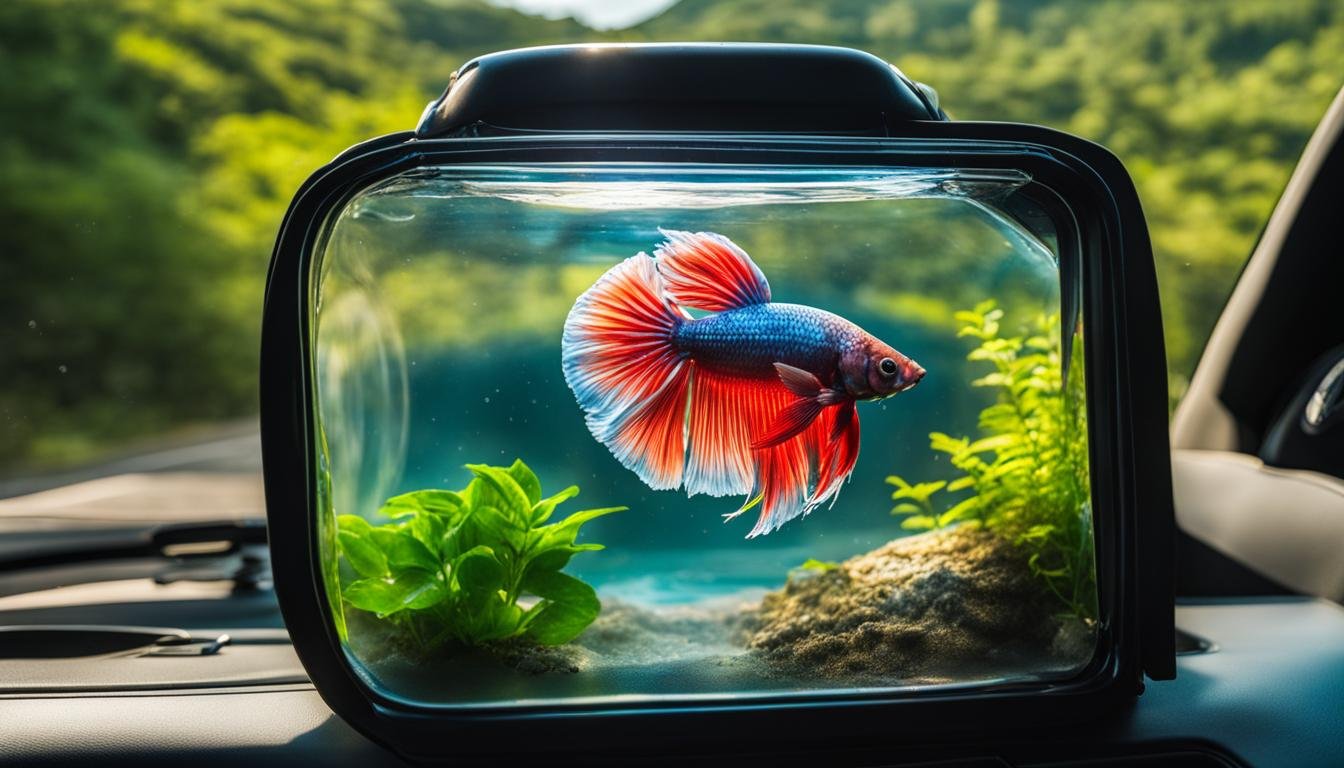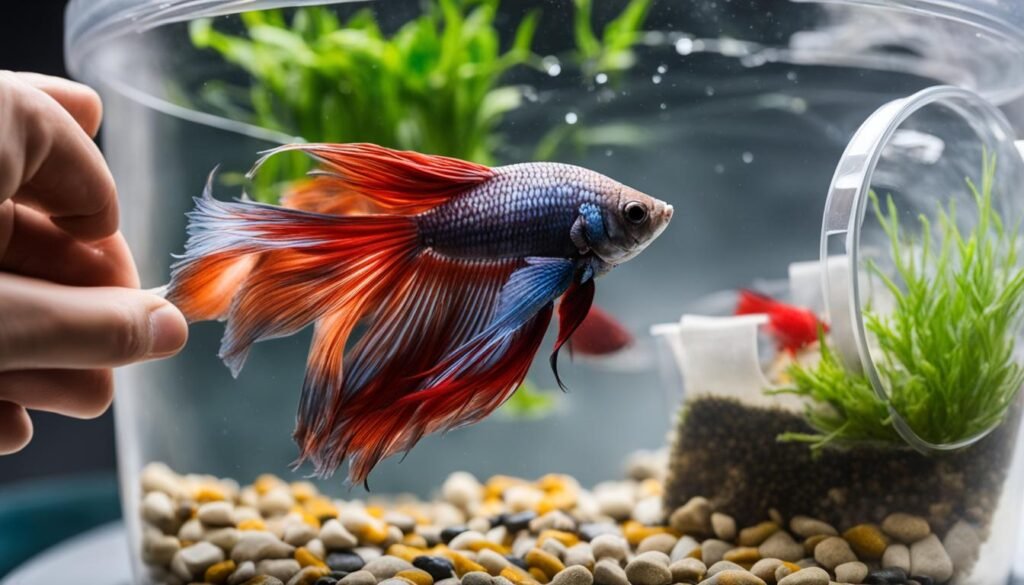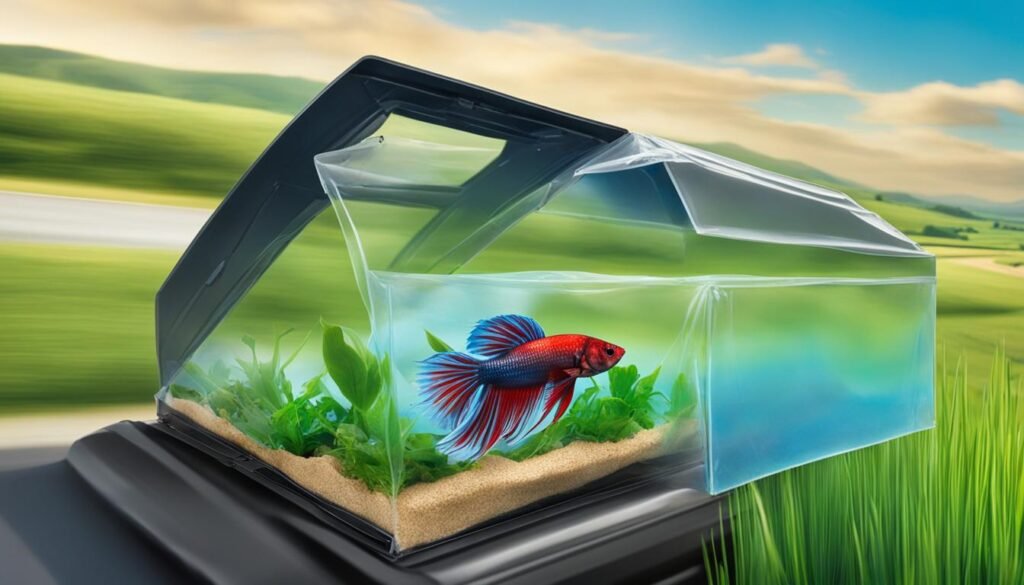Your cart is currently empty!

Guide: How To Safely Transport A Betta Fish Effortlessly
Transporting a betta fish may seem like a simple task, but there are crucial steps you need to follow to ensure a stress-free and safe journey for your fish. This guide will provide you with all the information and tips you need to transport your betta fish safely and effortlessly.
Key Takeaways:
- Learn the best practices for safely transporting betta fish
- Understand the guidelines for betta fish care during transport
- Discover transportation tips to ensure the well-being of your betta fish
- Follow recommended steps for moving betta fish safely
- Implement proper techniques for betta fish transportation
Situations that May Require Transporting Your Betta Fish
There are various situations where you may need to transport your betta fish. Whether it’s a routine vet visit or a relocation to a new home, it’s important to be prepared and ensure the safety and well-being of your fish throughout the journey.
1. Vet Visit:
If your betta fish requires medical attention and the vet cannot visit your home, you will need to transport your fish to their office. This may involve a short car ride, so it’s essential to have the necessary equipment and knowledge to ensure a comfortable trip for your betta.
2. Fish Relocation:
When moving houses or changing your address, it’s important to transport your betta fish safely to their new home. This involves a longer journey, and proper planning and precautions are needed to minimize stress and ensure a smooth transition for your fish.
By understanding the specific requirements and steps involved in transporting your betta fish, you can ensure their well-being and make the journey as stress-free as possible.
Transporting Your Betta Fish to the Vet

When it comes to transporting your betta fish to the vet, there are a few essential steps you need to follow to ensure a safe and stress-free journey for your beloved pet. First and foremost, you will need a small transport aquarium or container with a secure lid to prevent any accidental escape during the trip.
Next, fill the transport aquarium with water from your betta’s home tank. This will help maintain a consistent environment and reduce stress for your fish. Use a fish net to carefully scoop your betta out of its tank and transfer it to the transport aquarium. Be sure to handle your fish gently to avoid any injuries.
During the journey, it’s crucial to maintain a stable temperature for your betta fish. Keep the transport aquarium away from direct sunlight and ensure the car’s temperature is warm enough for your fish, ideally between 74-80°F (23-27°C). If the trip is longer than three hours, consider replacing some of the water in the transport aquarium with spare aquarium water to maintain water quality.
Steps for Betta Fish Transportation to the Vet:
- Prepare a small transport aquarium or container with a secure lid.
- Fill the transport aquarium with water from your betta’s tank.
- Gently scoop your betta fish out with a net and transfer it to the transport aquarium.
- Maintain a warm temperature (74-80°F/23-27°C) during the journey.
- If the trip is longer than three hours, replace some water with spare aquarium water.
By following these steps, you can ensure a smooth and safe journey for your betta fish to the vet, minimizing stress and promoting their well-being.
Transporting Your Betta Fish During a Relocation
Transporting your betta fish during a relocation requires careful planning and preparation. Follow these steps to ensure a smooth and stress-free journey for your fish:
- Choose the right container: The best container for transporting betta fish is a small transport aquarium with a secure lid. If you don’t have one, you can use two plastic bags and a sturdy container. Remember to avoid using containers made of materials that may release harmful chemicals into the water.
- Prepare the container: Fill the transport aquarium with water from your betta’s tank, making sure the water temperature is similar. If using plastic bags, fill them with enough water to comfortably accommodate your betta fish.
- Catch your betta fish: Carefully catch your betta fish using a net and place it into the transport aquarium or bag. Avoid overcrowding and ensure that there is enough space for your fish to move around comfortably.
- Secure the container: Close and seal the transport aquarium securely or tie the plastic bags tightly to prevent any leaks or spills. Place the container in an insulated box or cooler to maintain a stable temperature during the journey.
- Keep the environment stable: To minimize stress, place cushions or towels around the container to prevent excessive movement. Avoid exposing the container to direct sunlight or extreme temperatures.
- Drive carefully: During transportation, drive smoothly and avoid sudden stops or accelerations. Be cautious of speed bumps or rough roads that may cause the container to jostle.
By following these steps and taking the necessary precautions, you can ensure that your betta fish arrives safely at its new destination. Remember to acclimate your fish to the new tank gradually and monitor its health closely in the days following the relocation.
Tips for Betta Fish Transportation During a Relocation
- Do not feed your betta fish for 24 hours before the journey to minimize waste and prevent water contamination.
- Avoid using medications or chemical additives in the transport water unless recommended by a veterinarian.
- If using plastic bags, double bag them for extra security and to prevent leakage.
- If the relocation is lengthy, consider using ammonia chips or ammonia-neutralizing medicine to maintain water quality.
- Do not expose your betta fish to extreme temperatures or drastic temperature changes during the journey.
- After reaching the new location, take your time to acclimate your betta fish to the new tank water by gradually adding small amounts of water over several hours.
By following these tips and guidelines, you can ensure a safe and comfortable journey for your betta fish during a relocation.
Tips for Long-Distance Betta Fish Travel

When it comes to long-distance betta fish travel, proper preparation is crucial to ensure the well-being of your fish. Here are some tips to help you make the journey as smooth as possible:
1. Invest in a Suitable Betta Fish Travel Tank
Using a travel tank specifically designed for betta fish is highly recommended. These tanks typically come with secure lids and aeration holes to provide proper ventilation during the journey. The tank should be of an appropriate size to allow your betta fish to swim comfortably.
2. Maintain Water Temperature Throughout the Travel
Betta fish are sensitive to temperature fluctuations, so it’s important to keep their water at a consistent temperature during travel. You can achieve this by using heating pads or wrapping the tank with warm towels. Avoid exposing the tank to direct sunlight or extreme temperatures.
3. Fast Your Betta Fish Before the Journey
Prior to travel, it’s best to fast your betta fish for at least 24 hours. This helps prevent waste buildup in the tank, keeping the water clean and reducing the risk of ammonia spikes or poor water quality during the journey.
4. Do Not Feed Your Betta Fish During Travel
While it may be tempting to feed your betta fish during the journey, it’s best to refrain from doing so. Feeding can cause additional stress and contribute to poor water quality. Instead, focus on providing a calm and stable environment for your fish.
By following these tips, you can ensure that your betta fish travels safely and comfortably during long-distance journeys. Remember to monitor your fish closely upon arrival and acclimate them to their new water environment for a seamless transition.
Preparing for Betta Fish Travel

Before embarking on a journey with your betta fish, it’s important to make some preparations to ensure a safe and stress-free travel experience. Here are some key steps to follow:
Gather the necessary supplies:
- A small transport aquarium or container with a secure lid
- Extra plastic bags for other fish or aquarium plants
- Water-holding containers
Feed your betta fish before travel:
It’s recommended to feed your betta fish a few hours before the journey. This will allow them to have a meal before the trip without causing any discomfort or digestive issues during travel.
Change a portion of the water:
A few days before the trip, change a portion of the water in your betta fish’s tank. This will help maintain cleanliness and reduce the risk of ammonia build-up during travel.
Condition the travel water:
Before transferring your betta fish to the transport container, add a water conditioner to the travel water to remove any chlorine or harmful substances. Additionally, consider adding a small amount of aquarium salt to help reduce stress during the journey.
Tips for a Smooth Betta Fish Transport

Transporting your betta fish can be a delicate process that requires careful handling and attention to detail. To ensure a smooth journey for your fish, here are some essential tips:
- Handle your betta fish gently: Betta fish can be sensitive to stress, so it’s important to handle them with care. Use a fish net to gently scoop your betta out of their tank and transfer them to the transport container.
- Maintain temperature control: Betta fish are tropical fish and thrive in warm water. During transport, it’s crucial to maintain a stable temperature to prevent stress and health issues. You can use a portable heater or insulate the transport container to keep the water warm.
- Avoid stress: Stress can weaken your betta fish’s immune system, making them more susceptible to illness. To minimize stress, provide a calm and quiet environment during transportation. Avoid sudden movements or loud noises that can startle your fish.
Additional Tips:
- Use cushioning materials to prevent excessive movement of the transport container.
- Choose a secure transport container with a lid to prevent escapes.
- Drive carefully and avoid speed bumps or rough roads that can agitate your betta fish.
By following these tips, you can help ensure a smooth betta fish transport and reduce the risk of stress or health issues for your beloved fish.
Reacclimating Your Betta Fish After Travel

After a successful journey, it’s important to reacclimate your betta fish to their home tank gradually. This process helps them adjust to the new water conditions and minimizes stress. Here are some steps to follow when reacclimating your betta fish after travel:
1. Acclimating to New Water
Start by floating the bag or container with your betta fish in their home tank. This allows the temperature to equalize slowly and helps your fish adjust to the water parameters in their tank. Leave the bag or container floating for about 15-20 minutes.
2. Introduce Small Amounts of New Water
After 15-20 minutes of floating, carefully open the bag or container and add small amounts of the tank water into it. This helps your betta fish gradually acclimate to the new water conditions. Repeat this process every 10-15 minutes, gradually increasing the amount of tank water in the bag or container.
3. Refrain from Feeding
Avoid feeding your betta fish for the first day after travel. This allows them to settle down and reduces the risk of digestive issues. Once your fish have fully acclimated to the tank water, you can resume their regular feeding schedule.
4. Monitor Health Closely
Keep a close eye on your betta fish’s behavior and overall health after travel. Look out for any signs of stress or illness, such as loss of appetite, lethargy, or unusual swimming patterns. If you notice any concerning symptoms, consult a veterinarian who specializes in fish health.
By following these steps, you can ensure a smooth transition for your betta fish after travel and help them settle back into their home tank comfortably.
Conclusion
Ensuring the safe and stress-free transport of your betta fish is essential for their well-being. By following these best practices, you can provide a comfortable journey for your beloved fish.
Remember to handle your betta fish with care and avoid unnecessary stress. Maintaining a stable temperature in the transport container or tank is crucial, along with using cushioning materials to minimize movement.
Always prioritize the health and safety of your betta fish during transport. If you have any doubts or concerns, it’s best to consult a professional for guidance. With these tips, you can transport your betta fish confidently, knowing you’re providing them with the best care possible.
FAQ
Why do I need to transport my betta fish?
There are two common situations where you may need to transport your betta fish: a vet visit and a relocation. If you cannot have a vet visit your home, you may need to transport your fish to the vet’s office. Similarly, if you are moving houses or changing your address, you will need to transport your fish.
How do I transport my betta fish to the vet?
To transport your betta fish to the vet, you will need a small transport aquarium or container with a lid, spare water containers, and a fish net. Fill the transport aquarium with water from your betta’s aquarium, scoop your betta out with a net, and transfer it to the transport aquarium. Ensure that the temperature in your car is warm enough for your betta during the trip.
How do I transport my betta fish during a relocation?
When relocating your betta fish, you will need a small transport aquarium with a secure lid or two plastic bags and a container, spare plastic bags for other fish or aquarium plants, water-holding containers, a net, and ammonia chips or ammonia-neutralizing medicine. Properly pack and secure your fish and other aquarium items and drive carefully to avoid stress or damage to your betta fish.
How should I prepare for long-distance betta fish travel?
For long-distance betta fish travel, use a travel tank with secure lids and aeration holes. Cushion the tank to minimize movement and maintain water temperature using heating pads or warm towels. Fast your betta fish before the journey and do not feed them during travel. Acclimate your betta fish to the new water after arriving at your destination.
What preparations should I make before betta fish travel?
Before betta fish travel, feed your betta fish before the journey, change a portion of the water in their tank a few days before the trip to maintain cleanliness, and condition the travel water using water conditioner and aquarium salt.
How can I ensure a smooth betta fish transport?
To ensure a smooth betta fish transport, handle your fish gently, maintain a stable temperature in the transport container or tank, and use cushioning materials to prevent excessive movement. Drive carefully and avoid speed bumps or rough roads that can stress your betta fish.
How do I reacclimate my betta fish after travel?
After travel, reacclimate your betta fish to their home tank by floating their bag or container in the tank and gradually introducing small amounts of new water. Do not feed your betta fish for a day and monitor their health closely. If any issues arise, seek veterinary advice.
Leave a Reply